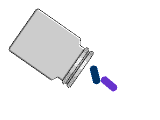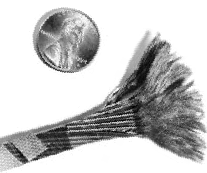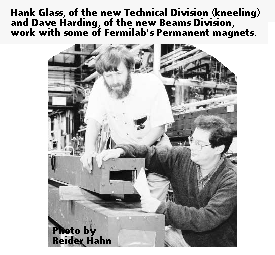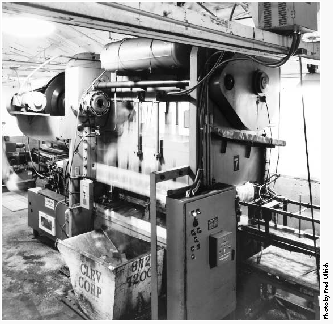![]()
 |
MAGNETS, PART II |
|
HANK
GLASS. In the last installment,
we learned what kinds of magnets Fermilab needs to run the accelerator.
Magnet fabrication technology is the subject of this part of the accelerator
magnet story . There's the old-fashioned, or "conventional," way to build magnets, based on the observation that when electric current travels through a loop of wire, the current creates a magnetic field. Wind the wire many times, and the field get stronger in proportion to the number of photo by Reider Hahn loops. Magnet builders can make this simple electromagnet even stronger by surrounding the wire coils with iron. Iron (along with few other materials) has a special property in that each iron atom acts like a tiny magnet. When placed in a magnetic field, the iron atoms orient themselves in such a way that they make the field stronger. Magnet builders can control such a magnet by varying the amount of current in the loop: more current means a stronger field. In an accelerator such as the Main Injector, strong fields are needed and, therefore, Fermilab needs to use large currents (nearly 10,000 amps for the dipoles). To carry such currents, the "wire" must be very big-the Main Injector dipoles use copper conductor that is 1"x 4" in cross-section. To carry away the heat generated by this current, magnet builders make a hole through the center of the conductor and circulate water. Superconducting Magnets There's a limit to the strength of the field one can generate in these conventional magnets. As the current in the coils increases, more and more iron atoms orient themselves with the field. One reaches a point where all of the iron atoms have gotten involved-the iron has become saturated-and it becomes harder to increase the field beyond this strength. To make stronger magnets, we need a different technology: superconducting magnets. Fermilab's Tevatron was the first synchrotron to use this type of magnet. In an ordinary conductor, such as copper, electrical resistance limits the current one can use. This resistance causes the copper to get hot when current passes through it. But certain materials have an amazing property in which they lose all resistance when cooled below a certain temperature. Fermilab magnet builders use cables made of fine strands of superconducting niobium titanium; the cables loop around the magnet many times. Since each superconducting cable can carry several thousand amps of current, magnet designers can make the total magnetic field, generated by all of these cables, very large. The niobium titanium wire only becomes superconducting when it is very cold; in fact, magnet builders bathe the wires in liquid helium at a temperature of four degrees above absolute zero (that's about 452° F). Superconducting magnets can achieve fields several times stronger than conventional iron and copper magnets. Therefore, the superconducting magnets can steer particles with the highest energies. There are some important limitations, however; superconducting wires can only carry so much current before they "quench," or become normal conductors. Therefore, superconducting magnets must operate at some safe level below the quench current. Magnet experts can make the quench current higher by cooling the conductor even more. An area of intense research and development today involves building magnets that operate at superfluid helium temperatures, only 1.8° K above absolute zero. Magnets for the Large Hadron Collider (LHC) at CERN will use these high-field, ultra- low-temperature magnets. Permanent Magnets There is a third magnet technology, one that uses permanent magnets, that Fermilab has just begun to explore. Both conventional and superconducting magnets require power supplies, contributing to their operating cost. Using magnets that don't need electric power is hardly an innovation-these, of course, are the kinds of magnets used to stick your shopping list to the refrigerator. What's new is the ability to make them precise enough so that they can operate in an accelerator. If one takes a piece of iron and places it in a strong magnetic field, the iron will become magnetized and generate its own field. But when removed from the field, it loses most of its strength, although there is usually some residual magnetization left over. Certain materials, however, remain highly magnetized even when removed from the original magnetizing field. These materials vary widely in magnetic strength and cost; one of the more inexpensive materials is a ceramic called strontium ferrite. Ferrite magnets are commonly found in stereo loudspeakers and in motors that operate power windows and power locks in cars. And soon, accelerator personnel at Fermilab will use ferrite magnets to steer protons and, perhaps, even antiprotons. Although not needing a power supply is clearly an advantage, it also presents a limitation, since the field in a permanent magnet is not variable. Magnet builders can precisely adjust the field during the manufacturing process; however, once a magnet of this type is built, it's hard to change. But there are several applications where fixed-strength magnets are useful. One example is in a transfer line, where the beam travels at a fixed energy from one accelerator ring to another. There are many transfer lines at Fermilab, and more are planned. For instance, once the Booster Ring has accelerated protons to an energy of 8 GeV (eight billion electron volts), the beam must shift over to the new Main Injector ring, where it will be accelerated to higher energies. Fermilab will build this long transfer line connecting the Booster to the Main Injector using more than 100 permanent magnets. Another possible application of permanent magnets is in a storage ring, a ring that circulates beam at a fixed energy. Such a ring might store antiprotons, as in Fermilab's proposed Recycler Ring. Fermilab accelerator personnel can't store antiprotons on a shelf in the stockroom; when antiprotons and ordinary matter come in contact with each other, they mutually annihilate, resulting in a very short shelf life. A better way to keep a supply of antiprotons handy is to circulate them in an ultra-high- vacuum pipe through a ring of magnets, so that they go round and round for hours until needed. Fermilab has been doing research and development in order to learn how to meet the precise tolerances required for storage rings using permanent magnets. |
Each dipole, or bending, magnet for the Main Injector, Fermilab's newest accelerator requires laminations that measure 11" x 30". The lamination stamping machine, shown at left, made a total of 2.5 million of these precise laminations. The stamping process took place at Electro Metal Products in Skokie, IL. The threeyear contract consumed 150 million pounds of steel. Photo by Fred Ulrich |
 A section of niobium titanium superconducting
cable with its strands frayed at the end for visibility.
A section of niobium titanium superconducting
cable with its strands frayed at the end for visibility.

 Main Injector Update
Main Injector Update